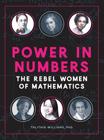- About MAA
- Membership
- MAA Publications
- Periodicals
- Blogs
- MAA Book Series
- MAA Press (an imprint of the AMS)
- MAA Notes
- MAA Reviews
- Mathematical Communication
- Information for Libraries
- Author Resources
- Advertise with MAA
- Meetings
- Competitions
- Programs
- Communities
- MAA Sections
- SIGMAA
- MAA Connect
- Students
- MAA Awards
- Awards Booklets
- Writing Awards
- Teaching Awards
- Service Awards
- Research Awards
- Lecture Awards
- Putnam Competition Individual and Team Winners
- D. E. Shaw Group AMC 8 Awards & Certificates
- Maryam Mirzakhani AMC 10 A Awards & Certificates
- Two Sigma AMC 10 B Awards & Certificates
- Jane Street AMC 12 A Awards & Certificates
- Akamai AMC 12 B Awards & Certificates
- High School Teachers
- News
You are here
Power in Numbers: The Rebel Women of Mathematics

Publisher:
Race Point Publishing
Publication Date:
2018
Number of Pages:
224
Format:
Hardcover
Price:
28.00
ISBN:
9781631064852
The Basic Library List Committee suggests that undergraduate mathematics libraries consider this book for acquisition.
[Reviewed by , on ]
Allen Stenger
08/7/2018
This is a series of brief biographies of woman mathematicians, running in time from Hypatia (died 415) to Pamela E. Harris (born 1983), but mostly contemporary. It’s not quite a coffee-table book, but has some of that feel, with lots of large full-color photos and illustrations. The length of the text of the biographies varies but usually runs about 3 to 4 pages. The author is an African-American woman statistician at Harvey Mudd College and hosts the public television series NOVA Wonders.
The book is inclusive, covering women who worked in business and industry as well as academia, and women who did mathematical work even if their degrees were in other fields (I didn’t realize that Ingrid Daubechies was trained as a physicist). The “Rebel” in the title is a dramatic exaggeration: a few of the women had rebellious temperaments, and most of them had to overcome opposition and indifference, but most of them were part of the intellectual and social mainstream.
Very Good Feature: for each mathematician, the author tells how she got interested in math. Usually this was an encouraging or inspiring high school or college teacher who saw potential. Some seem to have simply been born with an interest in numbers, that developed into an interest in math. Emmy Noether’s father was a prominent mathematician. Maryam Mirzakhani was a poor student in math, but her elder brother got her excited about science in general, and by the end of high school she had gravitated to math. Sylvia T. Bozeman’s parents were not well-educated, but her mother was always excited about math and passed this on to her daughter.
Generally speaking the book is light on mathematics itself. There are a few sidebars on math concepts, particularly those they have good visuals. The book often quotes the title of the doctoral dissertations, but without any further explanation or hint of what they might have been about.
Unlike many popular books, this one is carefully footnoted, and for each woman includes a list of works about her. It also gives a good general list of websites and books for further reading. I spotted a couple of minor errors: Sofia Kovalevskaya’s husband is listed as Vladimir Kovalevskaya instead of Kovalevsky (p. 27), and Georg Cantor (1845–1918) is described as a seventeenth-century mathematician (p. 177)
Bottom line: a quick read and full of dramatic stories and eye-catching illustrations. It has something of the flavor of Bell’s Men of Mathematics, but is less technical and more factual. It’s a good bet for inspiring bright young women to have an interest in math.
Allen Stenger is a math hobbyist and retired software developer. He is an editor of the Missouri Journal of Mathematical Sciences. His personal web page is allenstenger.com. His mathematical interests are number theory and classical analysis.
Introduction
PART I: The Pioneers
WANG ZHENYI
SOPHIE GERMAIN
SOFIA KOVALEVSKAYA
WINIFRED EDGERTON MERRILL
EMMY NOETHER
SPOTLIGHT: Breaking the PhD Color Barrier
PART II: From Code Breaking to Rocket Science
GRACE HOPPER
MARY GOLDA ROSS
DOROTHY VAUGHAN
KATHERINE G. JOHNSON
MARY WINSTON JACKSON
SPOTLIGHT: From Circus Performer to Human Computer
ANNIE EASLEY
MARGARET HAMILTON
PART III: Modern Math Mavens
SYLVIA T. BOZEMAN
FERN Y. HUNT
MARIA KLAWE
AMI RADUNSKAYA
INGRID DAUBECHIES
SPOTLIGHT: Mathematical Crochet
TATIANA TORO
KAREN E. SMITH
GIGLIOLA STAFFILANI
ERICA N. WALKER
TRACHETTE JACKSON
CARLA COTWRIGHT-WILLIAMS
EUGENIA CHENG
MARYAM MIRZAKHANI
CHELSEA WALTON
PAMELA E. HARRIS
Notes & Further Reading
Acknowledgments
Image Credits
Index
- Log in to post comments




